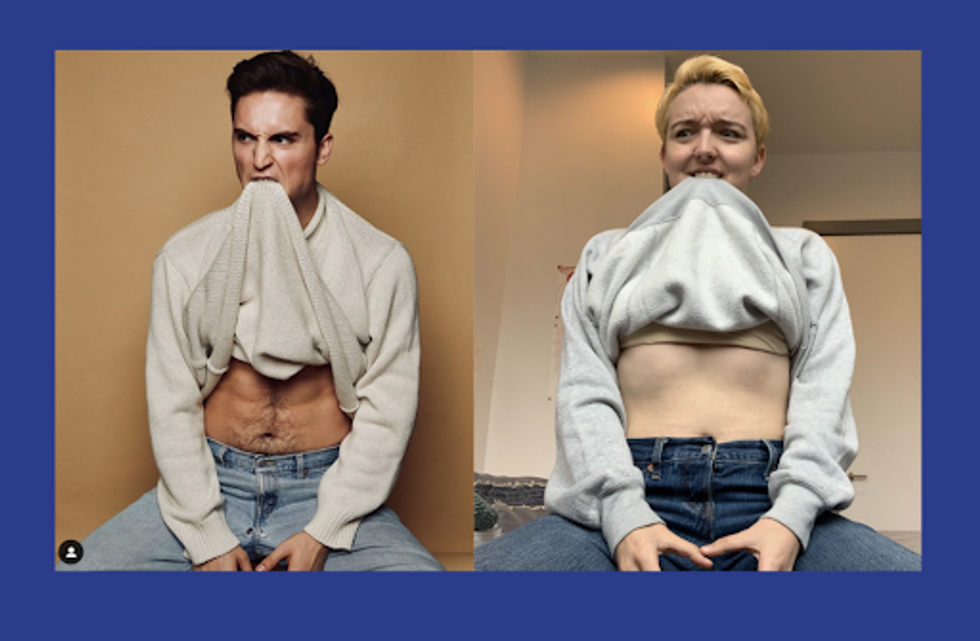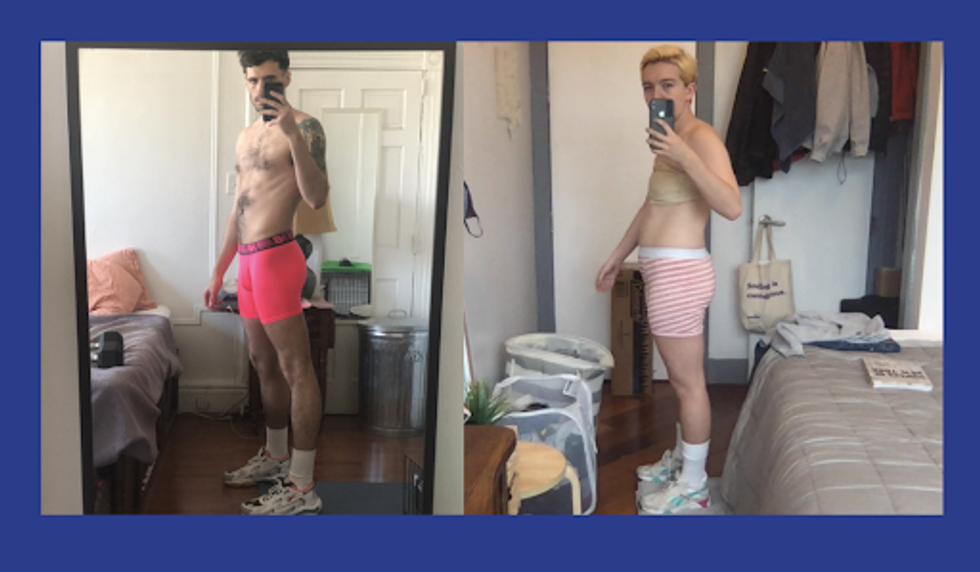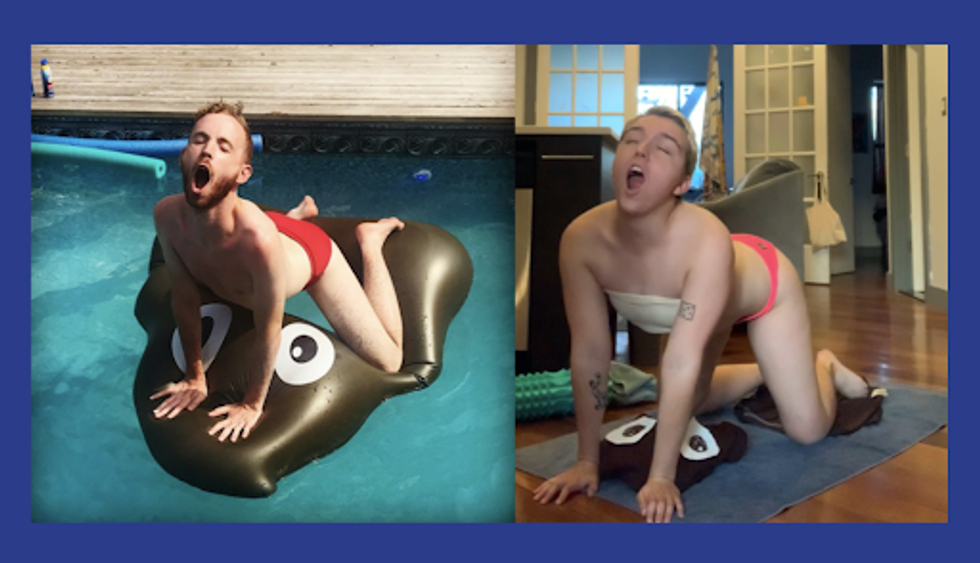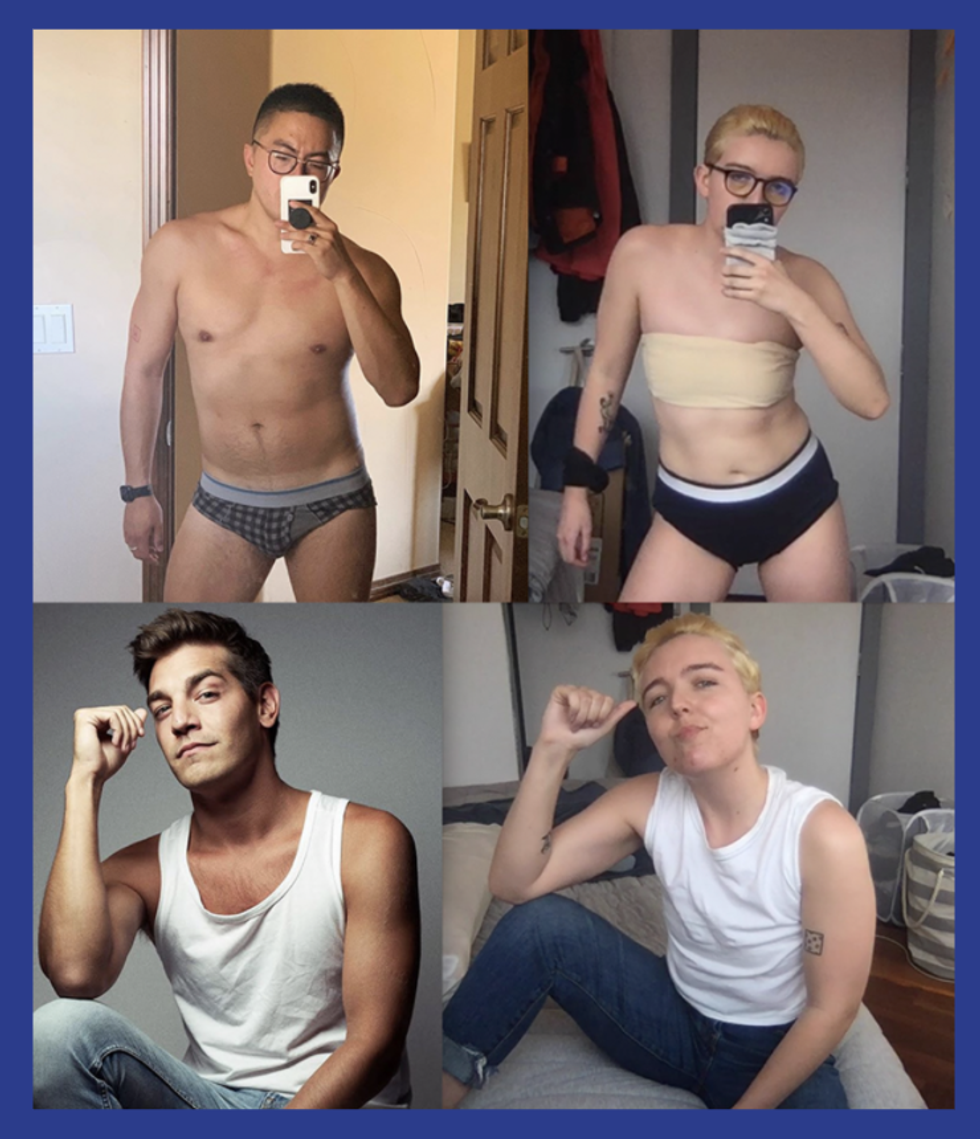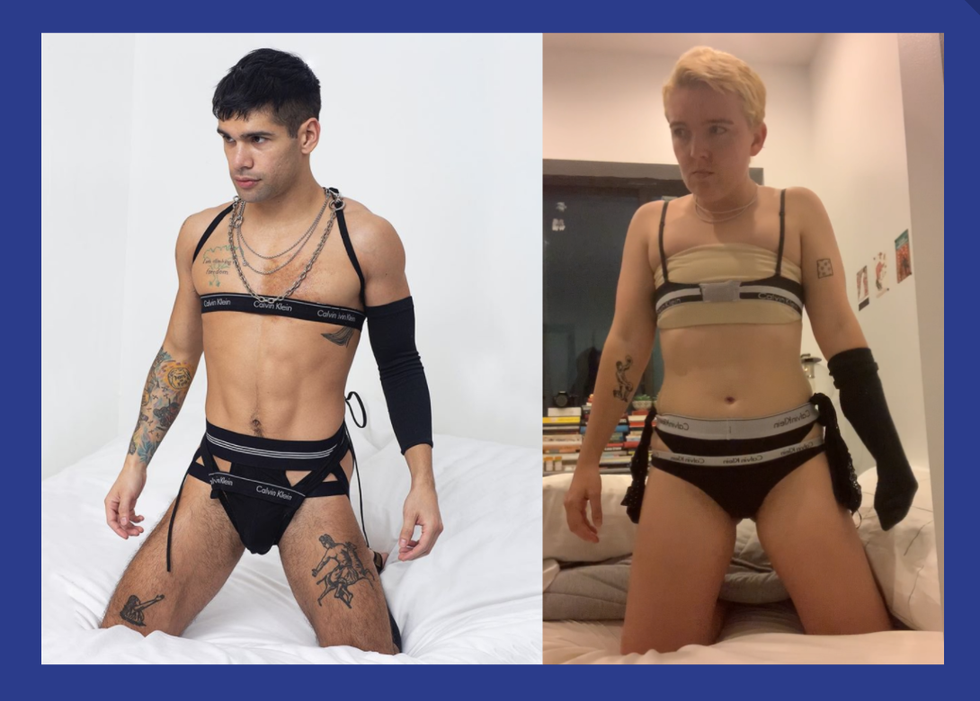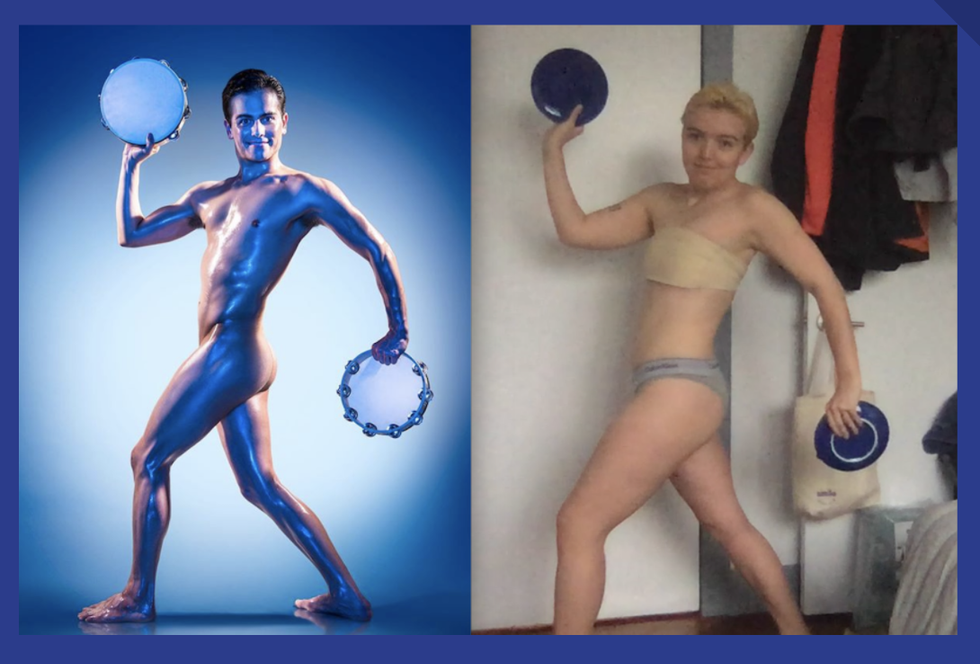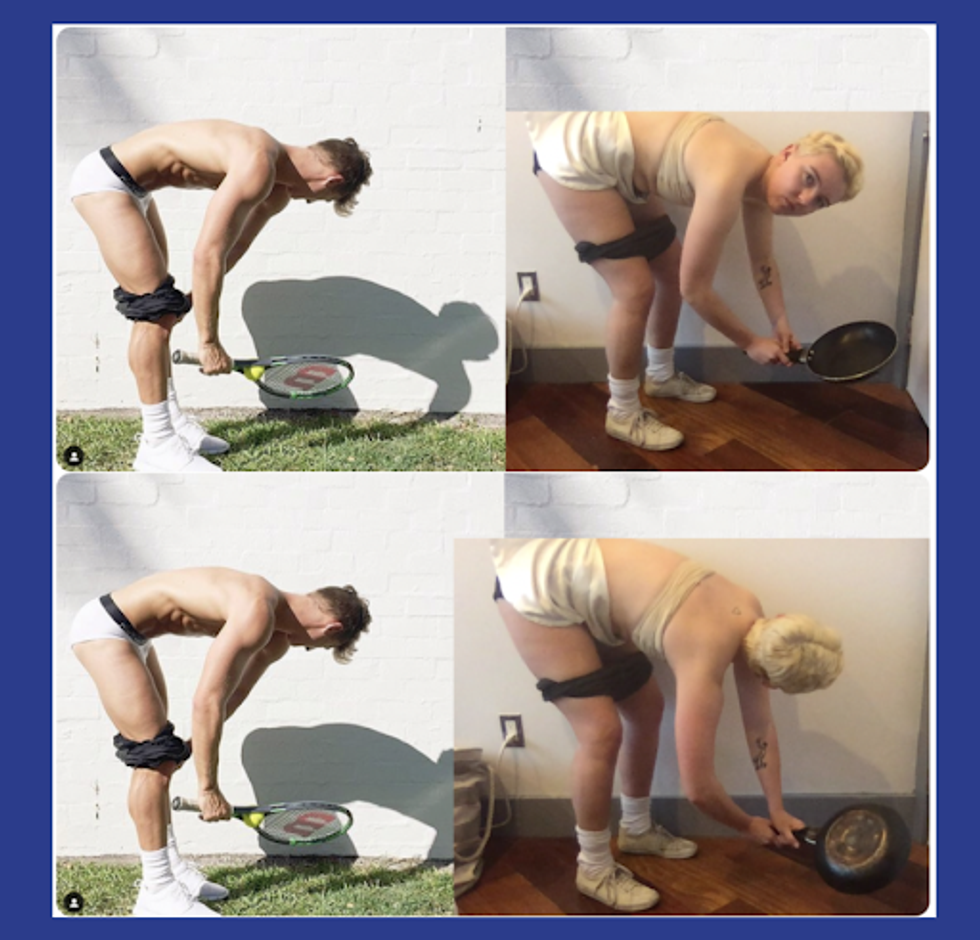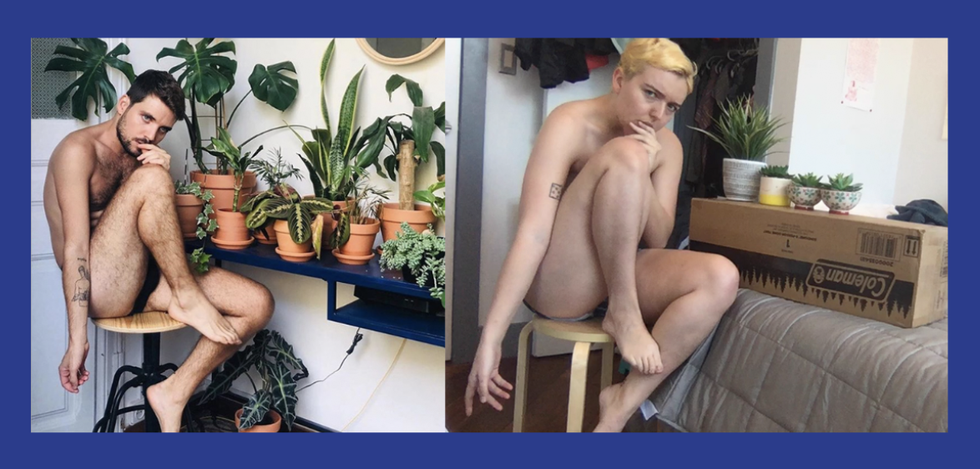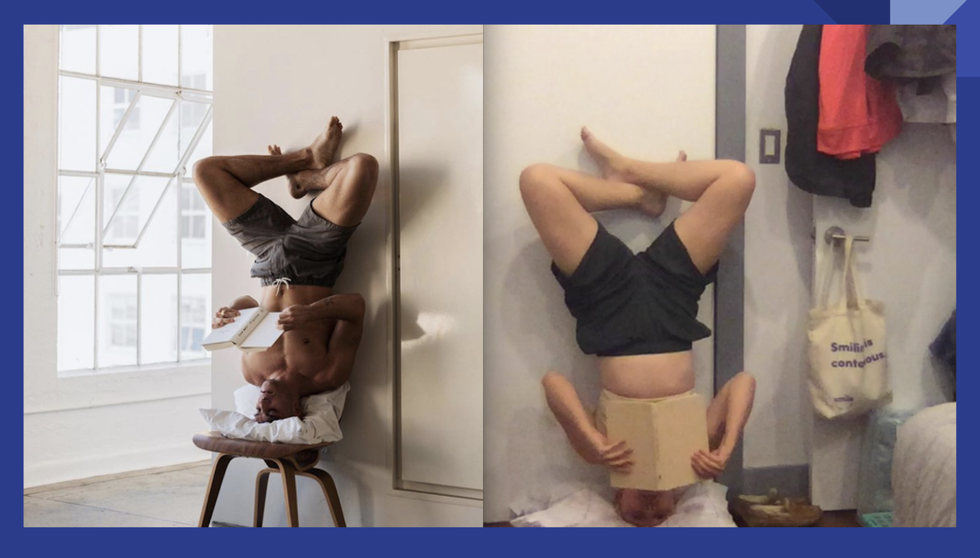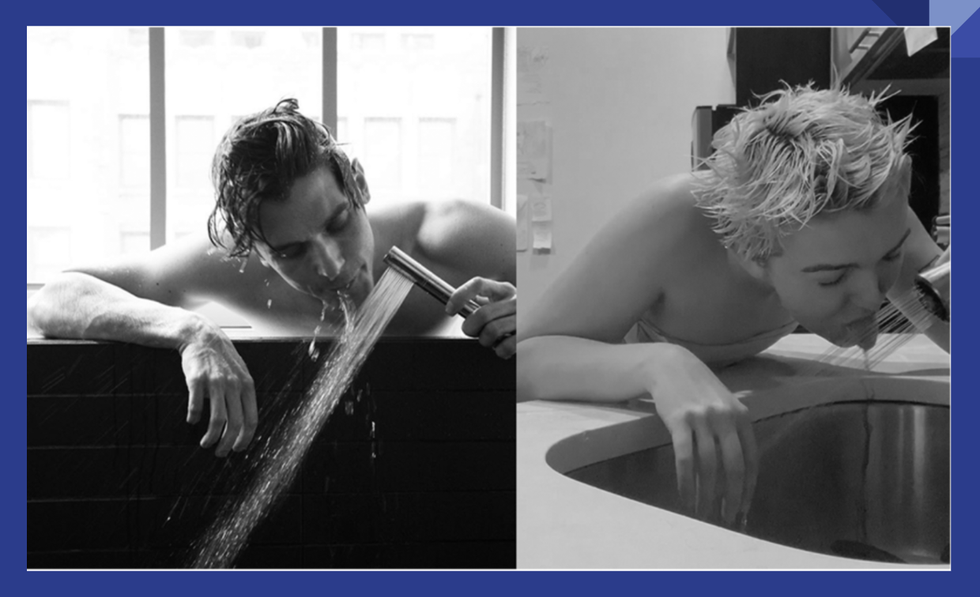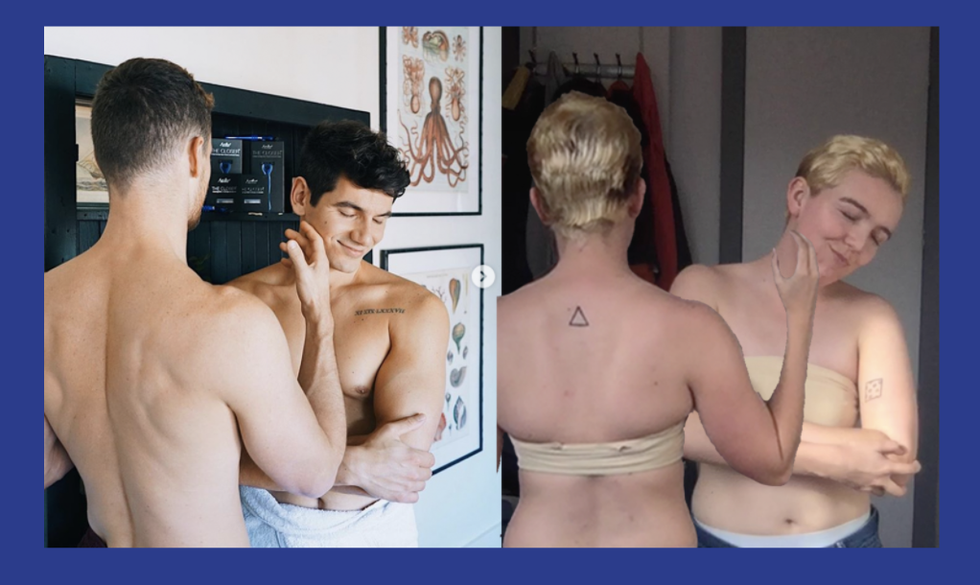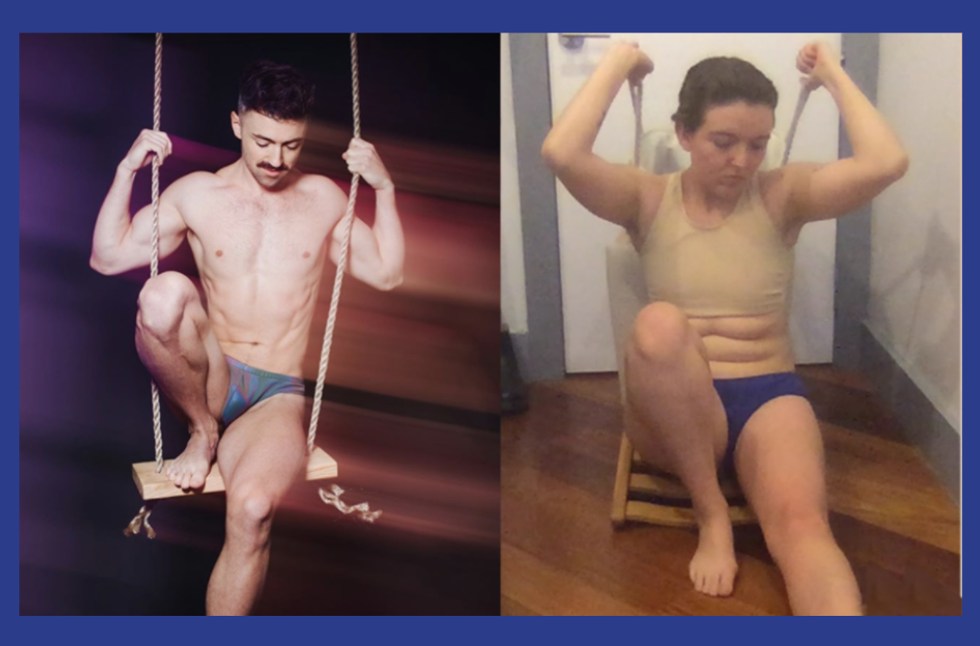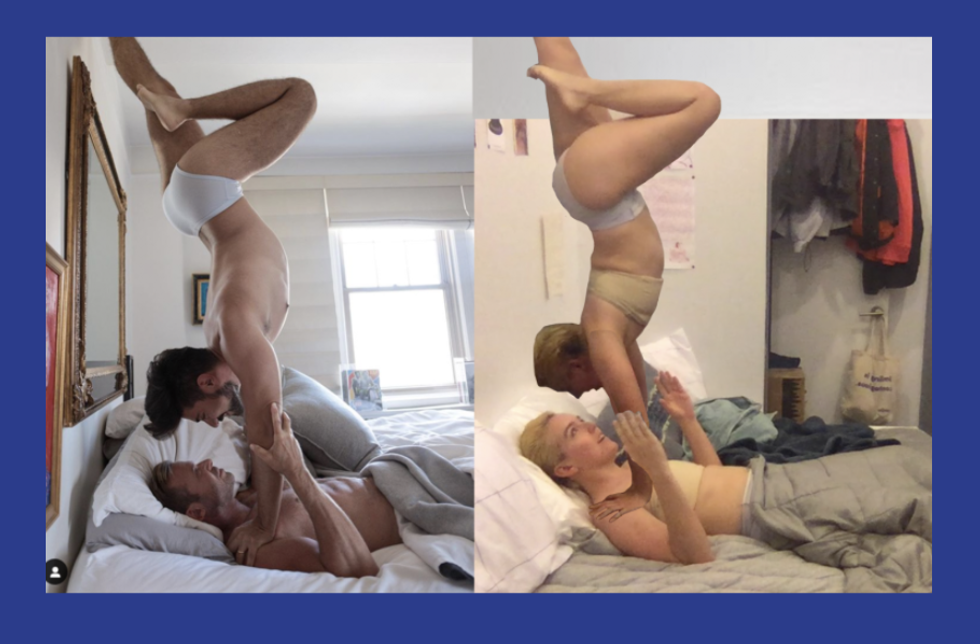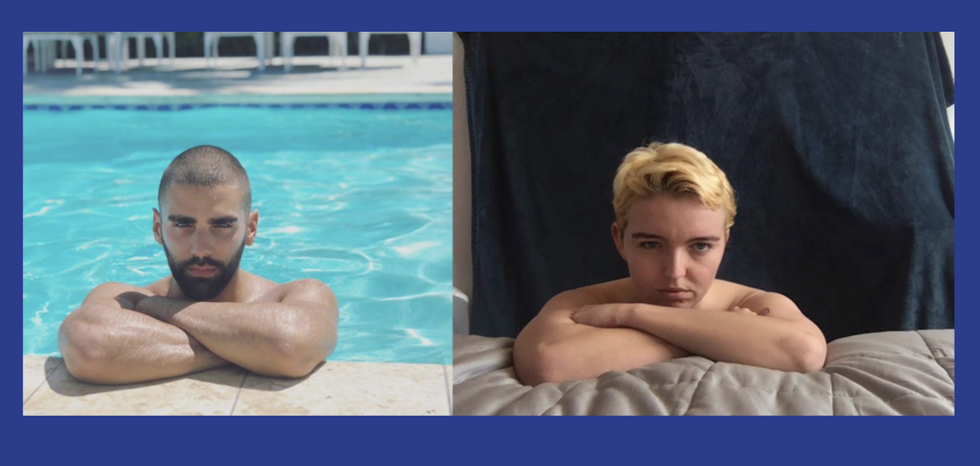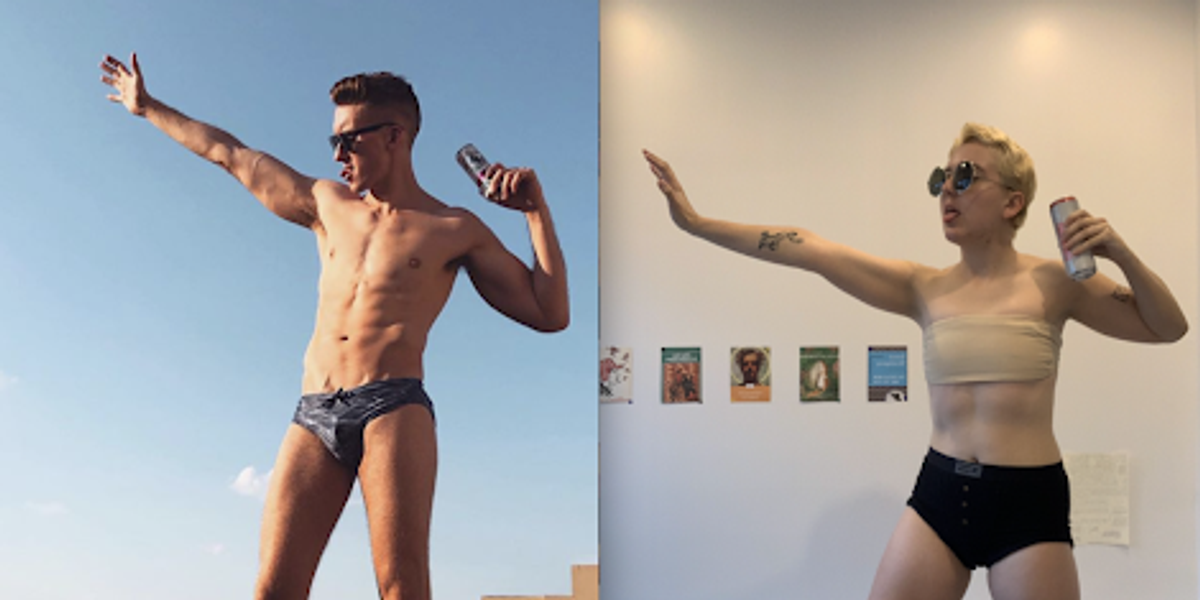
When I was a kid, I would get ready for school in the dark. Oftentimes my sister would enter in the middle of my dimly-lit routine, switch on the lights and unintentionally force me to look at myself. Depending on my mood, I'd cry or yell or quietly leave to put a waffle in the toaster. I felt, for lack of a better word, trapped.
I'm a nonbinary transmasculine comedy person who has been growing increasingly frustrated while finding my place in the queer community and the comedy community (which, in Brooklyn, are very closely aligned). Before quarantine, I'd stand onstage driving myself crazy with the question of "what I offered" to the audience. I'm not a hot gay boy or a cool lesbian or the makeup-wearing, glitz-and-glam comedy girl that the internet loves. I felt, and still often feel, like a pile of dust shouting into a microphone.
Related | This Generation of Comedy Is Queer
Three weeks into lockdown, I was scrolling through Twitter and came across a viral photo of a guy lying on his stomach with his butt prominently featured, a hint of his computer visible in the right hand side of the shot. The caption: Being micromanaged in my underwear is much better than being micromanaged at the office. I laughed and sent it to a friend. "If I recreated this, you think my trans dyke ass would get 5k likes?" "LOL maybe," she replied.
I knew the answer was more of a definitive no, but I did it anyway.
It took me a solid 20 minutes to properly twist and lock my body into the position of my muse. I snapped a pic, my face pained with the strain of the contortion. Gave it the old college try!, I typed before pressing send. The picture loaded in the comment section of the original tweet. And people loved it. I loved that people loved it. The subject of the satirized photo DM'd me: "This is so funny. You should do more." And with that, my 100+ thirst trap journey began.
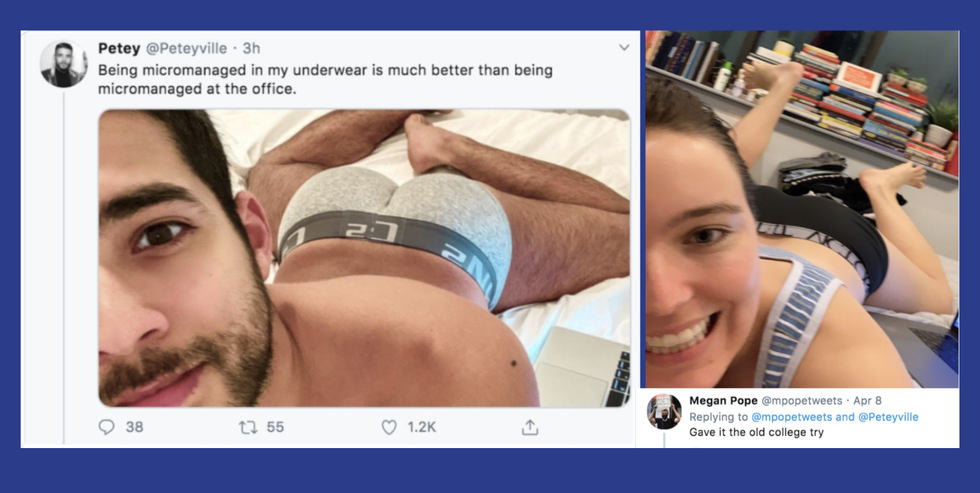
For eight weeks, I spent hours scrolling through Instagram, clicking through pics of hot blonde boy accounts and topinstagaythirstxxx sites for the silliest poses. I recreated them in my room, slapping an exaggerated caption across the top — usually some inspirational quote or lyric akin to the original caption, framed in rainbows, glitter or emojis.
After the first 30 pics, I got a flood of DMs telling me I was "doing the lord's work" by dragging the Instagays. The gays themselves would re-post the parodies with comments like "ART!" and even "Oh my god, I think I'm in love with you."
It's rare for cis men to recognize non-binary/trans people like myself (let alone re-post photos of bodies like mine in boxers and a binder), but thanks to the lubrication of comedy, these boys were liking, retweeting, and DMing me new photos to recreate.
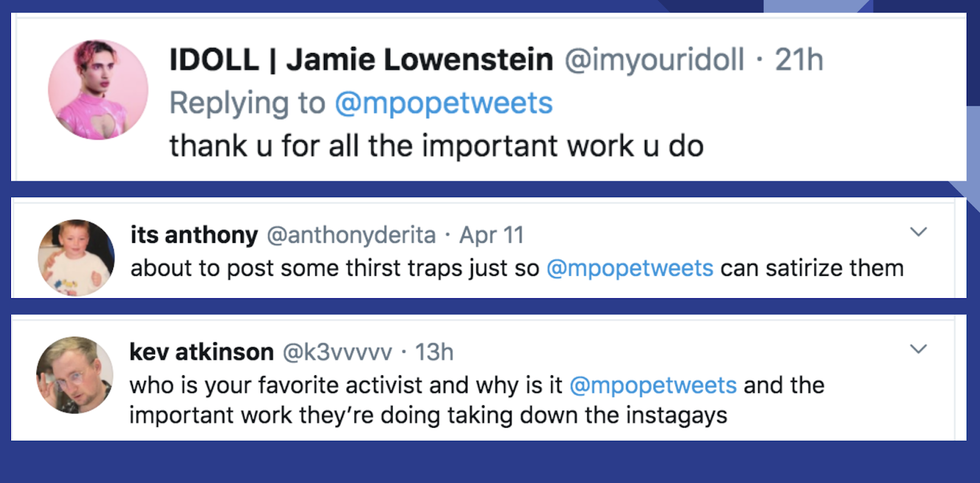
People were responding to what I was doing. But what was I doing, really? And what was it doing to me?
About 30 thirst traps into my project, I stood, bent at the waist, pants around my knees, holding a pan as a tennis racquet. I struggled to stifle my laughter as the Photo Booth app counted down. Once the shot was complete, I got up and examined myself. Overhead lights on, window open. And I felt… hot?
As previously established, I've never been a fan of my visage. I'm constantly complaining to my therapist about how hard it is to have a sense of self if your very identity is rooted in the lack of clear-cut distinctions and boxes. Everything's a spectrum, yada yada, but it's nice to have some footholds. I have very few. I'm king of undercutting and flipping. At this point, the only thing I can really trust is viscerality. And these dumbass thirst traps were making me feel both physically and viscerally good.
For the first time in a long while, I felt dropped in. Trans, boyish and confident. I was no longer floating above myself looking down. I had a torso and legs and arms — I could feel them, and I didn't hate them. I was astounded and thrilled and pissed that it took recreating photos of hot cis gay (mostly white) men to make me feel this way. But hey, I'd take the confidence.
Unfortunately, this newfound confidence also came with an addiction to control and feedback. I began going on two runs a day, posing in the morning before I had eaten. I learned my angles and how to exaggerate my face to make it clear that I was mimicking these boys, while not looking too crazy. Some days I'd let my face and body hang limp in front of the camera for added comedic effect. Other days, I'd suck in my stomach and choose the shot where I looked the "hottest."
I would assure people that this project "wasn't about the likes" and "as long as the satirized subject responds, it's worth it." After all, wasn't that the point? To hold a mirror up to their… mirror pics? Or was this way more about me than I was willing to admit?
Into weeks six, seven, and eight of quarantine, my obsession raged on, a powerful combination of the social media dopamine system and an addiction to my own newfound boy bravado. I found myself strategically choosing thirst trap subjects based on their accessibility to fame ratio. If I vaguely knew the person but they also had bajillions of followers? Excellent. If I didn't know them, but they tended to be responsive? Even better.
Around 60 traps in, I decided it was time to level up. I started choosing photos that were already very extreme and heightening them (see: the photo of Kyle Kreiger reading upside-down atop a wobbly chair. I opted to read in a headstand on top of a safely grounded pillow; even so, my body seized as I waited for my self-timer to go off. If you look at the picture, my face is beet red).
The constant oscillation between body confidence, comedic confidence and anxiety was strange. I had never felt more "me," more okay with a camera, with posting online. I also had never felt thirstier for likes, retweets, validation.
After about 100 thirst trap parodies, I got a DM from a distant friend: "This many white gays is triggering lol." "The sheer amount definitely says something," I replied. "What we knew all along," he wrote back.
This wasn't illuminating anything new. I was a white trans gay recirculating pictures of (mostly) white cis gays. My friend's DM agitated a well of anxiety I have about my gender and gendered power dynamics. Why do I feel so drawn to male culture and looking like them? The very group I was taught to "rebel against" and "stand-up to" as a student at an all-girls school, in all-female identifying groups in college, as a person assigned female at birth? Is it because I genuinely feel this way, in my body? Or is it because, no matter how you're conditioned, you're always going to be attracted to status?
Like the traps themselves, my gender identity feels like a cycle of perverse perpetuation. Performing and re-performing tropes that I've been taught to embrace or push back against on a loop. Before quarantine, I'd stand onstage at comedy shows and try to control my feminine gestures. I'd get frustrated when people would applaud my giggly-girly nature and call me "cute." I would try to do comedy without smiling to be read as more of a boy. I wanted to prove my worth as a genderfucked comedian, and part of proving that worth meant contorting myself to fit a certain ungendered or masculinzed ideal.
There's a similar pattern among the Instagays. In this article, Instagay @Brogan speaks to femme-shaming and getting external validation for working so hard to meet a hetero standard of uber-masculinity. He echoes similar themes and questions I relentlessly ask myself: Do you want to look, feel, and act this way because it physically feels right? Or are you attracted to what the world has deemed attractive? Instagays "pose like men" so that people will engage with them online. I was posing like a man to get people to engage with me online. Or to get them to laugh along with me online. Or to get them to laugh...at me?
I've been nervous to interrogate the specific humor of my thirst trap project, partly because I think the success of it is rooted in my (again, albeit white and able) otherness. Most people seeing the thirst traps still read me as a girl. I've gotten dozens of comments like "yes queen" "she nailed it," etc. "Haha she looks so funny." And that is the humor of it all, right? How I didn't look hot? How I didn't look like the Instagays? Good. I didn't want to, right? If a cis dude was doing this, would it be as humorous? No. My AFAB body, lack of six pack abs and trans-ness plays a huge role in the shock value of it all. My non-male-ness is a laugh trigger.
It's also confusing to do a project so rooted in parody and irony when parody and irony rely on clear-cut flippage: binaries and opposites. And that's not how I want people to read me. In terms of comedy, gender, personhood, anything. Humor and laughter are triggered when expected scripts are broken in a non-threatening way. There has to be a certain amount of safety established, so when the rug is pulled out from under you, you can laugh. I am "cute," "girly," white and weird. To many, that makes me safe.
For a majority of my life I was told that I hated attention. I was fed phrases about how my "brand" and "whole thing" was not-wanting-to-be-looked-at. Only later in life, after doing a bunch of performing, socializing and soul-searching, did I realize the falsehood of these statements.
Sure, I'd get ready for school in the morning like a blindfolded chef making a salad, tossing things around aimlessly, drizzling makeup across my face, and shouting "dressed" without seeing the fully-lit product, but that didn't mean I didn't desperately want to be seen. Nobody's "whole thing is that they don't want to be looked at." Some of us just internalize comments of the sort for so long that we trap ourselves in the lore. Our systems grow defensive, confusing the attention we so desperately need with what we've been told we don't want.
In her essay on Little Women, Drew Gregory writes, "Since transitioning I've recoiled at the suggestion that this was all for happiness. People say whatever makes you happy, or if you're happier, then it's worth it. But I didn't transition so I could be happier. I transitioned so my sadness could feel like my sadness instead of somebody else's."
This project is mine — I think. The increased confidence I have felt is personal. The performing and control, while sometimes unhealthy, confusing, and overwhelming, is mine. The attention, though maybe split between the boys in my photos and my weird, silly body, was drummed up, sparked and orchestrated by me. Despite all the noise, this feels like my own. Which is cool. Because, as demonstrated by my constant questioning onstage, I rarely make or do things for myself. I've been too worried about what other people want from me.
If I had taken 100+ parody thirst traps and kept them to myself, would I be feeling the same surge of confidence? Probably not. But that's fine. Circus performers contort themselves to fit into a box, which we marvel at and pay to see. Brands reach out to these Instagays to have them sell things. Which makes sense. They have a highly engaged audience. But it's also lifting the already elevated. Dual male households make way more than male-female, female-female, and non-male households. These white boys are gay, and it's great that they are making money and creating some sort of queer visbility, but they're also (some consciously, some unconsciously) perpetuating loads of racism, transphobia, ableism and misogyny in return. This is one of the many reasons why, when people DM me lesbian thirst traps to recreate, I won't do them. They don't feel as "funny" to me.
I've come to the point in the essay where I'm supposed to talk about what I've learned and what I will do moving forward. I am supposed to talk about how I've woken up from my thirst-trapped-obsessed, body dysmorphic, dopamine-dependent fugue state. But I haven't. I don't want to lie. I'm still thirsty for attention online. I'm still going on runs and looking at photos of Instagays and brainstorming ways to make myself look better while "leveling-up." In many ways I'm still trapped. I'm still selling myself online. I'm still implicitly biased and selfish.
I am happy that I tricked white cis gays into having to interact with a body like mine. I am sad that most of us need to see ourselves reflected in a world that's not ours in order to feel comfortable enough to step into it. I am confused and interested and now extra-aware of the little game of catch we're playing. I throw myself at you. You throw yourself back at me.
Instagram really is, in its simplest form, a place where we look at attractive people and hope to be seen as attractive by others in return. I think that's scary. I think that's stupid. And I think that's okay. Sometimes we need things to make us not feel like little piles of dust. And those things aren't always lovely or wholly unproblematic. This project did that for me, and I hope it provided people with a little bit of laughter in return.
As for the thirst traps? I hope to continue them, but work on self-compassion. After all, to loosely quote my original thirst trap subject: if I'm gonna micromanage myself, I might as well do it in my underwear.
